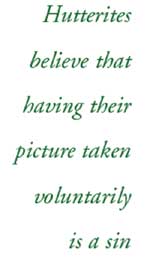No Pictures, Please
Elfriede Volk March/April 2008
Getting your Trinity Audio player ready...

Although driver's licenses issued since the mid-1970s have included a photograph of the driver, an exception was made for those with sincere religious objections. In 2003, however, the Alberta government decided to make photo ID on licenses mandatory in order to prevent identity theft and boost security against possible terrorist attacks. Peace-loving Hutterites from the Wilson Colony near Coaldale felt it was against their religious convictions to have their pictures taken, and as a result licensed drivers in the colony declined by attrition from 37 to 15 as expiring licenses were not renewed.
Taking their case to court, the Wilson Hutterites recently won a victory, as Justice Sal LoVecchio of the Alberta Court of Queen's Bench ruled in their favor. However, the decision of the jurors was not unanimous. Some felt that, with the availability of trucking services, the Hutterites could still continue their farming operations even if no one in the colony had a valid driver's license.
The Alberta government appealed the case to the Supreme Court of Canada.
Hutterites themselves are also split on the issue and LoVecchio's decision. Mark Waldner, from another colony, says that "some Hutterites, including myself, contend that. . . as long as we don't make an idol out of those 'images' we aren't trespassing the commandment." When my family visited a colony near Ponoka 30 years ago, we found the young ladies eager to have their picture taken with us, and they gave us their names and addresses so that we could send them the prints when they were developed.

So what is the problem? Why do some strenuously object to having their pictures taken while others welcomed the opportunity? Is having a driver's license a right? Is it necessary for the survival of a farming community? Hutterites believe in the greater good for more people. Would having picture identification on their licenses ensure security and public safety for more people? Canada's top judges will have to wrestle with a fair way to apply the rights of this very private group.
It is informative for an outside observer to look closely at how the Hutterites arrived at their objection of faith.
Although the Hutterites learn English in school, they still converse among themselves and have their services in Low German. At the end of the nineteenth century, when the Hutterites came to Canada, Luther's translation of the Bible was the one used almost exclusively. Here the second commandment contains a prohibition against making a Bildnis. Bild is the German word for "picture," so one can see how some obtained their belief that having picture identification would be a sin. But we must also remember that Luther worked on his translation alone and may have missed some of the nuances of the Hebrew language.
Since then, in 1909, the Elberfeld translation was issued by R. Brockhaus. In this translation the prohibition is against making a geschnitztes Bild , or "carved picture" or image. This is more in line with the original pesel, which means "graven, cut, or hewn image." Reading the rest of the commandment makes it clear that it concerns making and worshipping these things, as Waldner realized.
Elfriede Volk is a freelance writer living in Summerland, British Columbia, Canada.